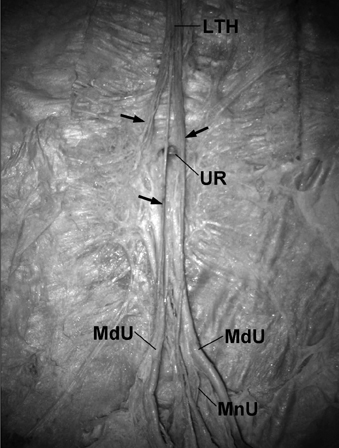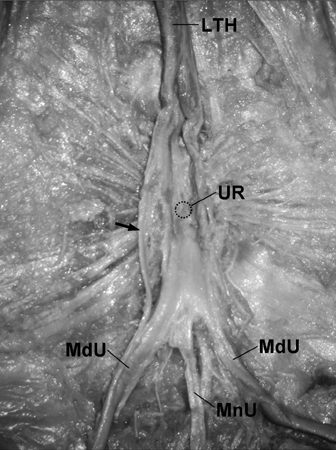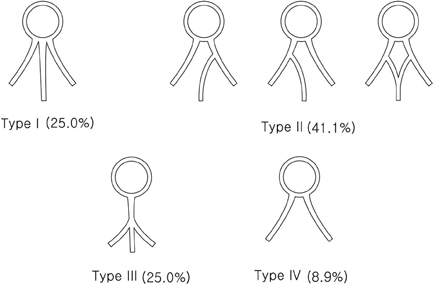Yonsei Med J.
2008 Dec;49(6):1004-1007. 10.3349/ymj.2008.49.6.1004.
Morphologic Variations of the Umbilical Ring, Umbilical Ligaments and Ligamentum Teres Hepatis
- Affiliations
-
- 1Department of Anatomy, Samsung Biomedical Research Institute, Sungkyunkwan University School of Medicine, Suwon, Korea. chinhy@yuhs.ac
- 2Department of Anatomy, Yonsei University College of Medicine, Seoul, Korea.
- 3Department of Surgery, Samsung Medical Center, Sungkyunkwan University School of Medicine, Seoul, Korea.
- KMID: 1782950
- DOI: http://doi.org/10.3349/ymj.2008.49.6.1004
Abstract
- PURPOSE
The varied morphology of the umbilical ring and its surrounding structures, such as the ligamentum teres hepatis, and the median and medial umbilical ligaments, has not been thoroughly investigated. Hence, this study was undertaken to clarify the morphologic variations of these structures. MATERIALS AND METHODS: The anterior abdominal walls were removed en bloc from 57 adult cadavers and dissected under a surgical microscope. RESULTS: One case of umbilical hernia was observed, and the remaining 56 umbilical rings were classified into 3 types: oval or round in 33 cases (Type A, 59.0%), obliterated or slitted in 12 cases (Type B, 21.4%), and completely covered by a connecting band between the ligamentum teres hepatis and umbilical ligaments in 11 cases (Type C, 19.6%). The median and medial umbilical ligaments were classified into four types based on their interrelationships. The most common type was the median umbilical ligament terminated by joining one or both medial umbilical ligaments (Type II, 41.1%). The ligamentum teres hepatis frequently ended by dividing into several branches in the area cranial to the umbilical ring, some of which crossed the umbilical ring. The umbilical fascia covered the umbilical ring in 50.0% of cases, and the rest either not covering the ring or not existing. CONCLUSION: These results are expected to improve our understanding of the anatomy of the umbilical area, and further improve treatments of the umbilical hernia.
Keyword
MeSH Terms
Figure
Reference
-
1. Lemmer JH, Strodel WE, Eckhauser FE. Umbilical hernia incarceration: a complication of medical therapy of ascites. Am J Gastroenterol. 1983. 78:295–296.2. Kives SL, Lara-Torre E. Pyogenic sacroiliitis following an infected umbilical ring. J Pediatr Adolesc Gynecol. 2004. 17:125–129.
Article3. Orda R, Nathan H. Surgical anatomy of the umbilical structures. Int Surg. 1973. 58:458–464.4. Friedrich K, Vogel HM, Henning H. The importance of variant insertions of the ligamentum teres hepatis in the Cruveilhier-Baumgarten syndrome. Endoscopy. 1988. 20:254–259.
Article5. Hammond G, Yglesias L, Davis JE. The urachus, its anatomy and associated fasciae. Anat Rec. 1941. 80:271–287.
Article6. Ikossi DG, Shaheen R, Mallory B. Laparoscopic femoral hernia repair using umbilical ligament as plug. J Laparoendosc Adv Surg Tech A. 2005. 15:197–200.
Article7. Martin BF, Tudor RG. The umbilical and paraumbilical veins of man. J Anat. 1980. 130:305–322.
- Full Text Links
- Actions
-
Cited
- CITED
-
- Close
- Share
- Similar articles
-
- Abscess Formation Involving the Falciform Ligament and Ligamentum Teres
- Ligamentum Teres Injury: Anatomy, Biomechanics, Diagnosis and Treatment
- Classification of Umbilical Vein Anomalies Based upon Cases in Dead Fetuses
- Minimally Invasive Treatment of Falciform Ligament Abscess in a 25-Day-Old Neonate: A Case Report
- A peculiar liver with surgically and radiologically important variations: a case report






